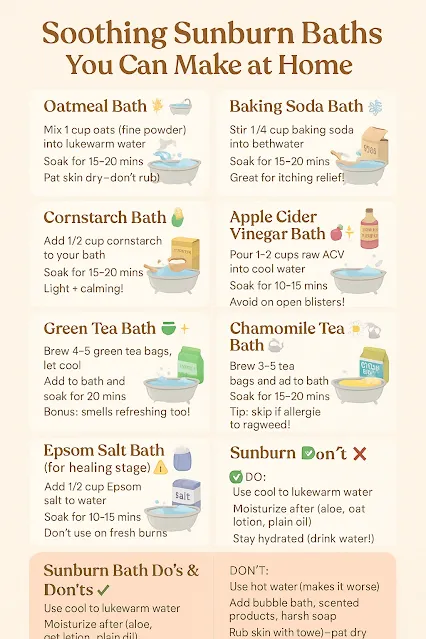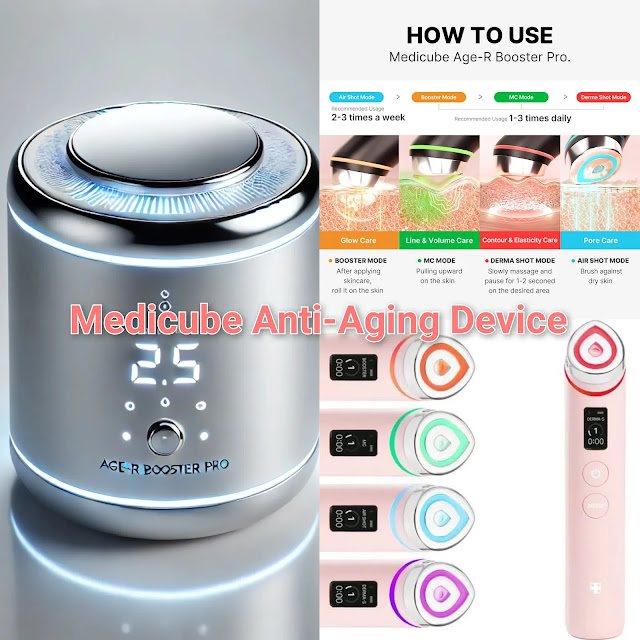Sunburn Explained:
Natural Relief ☀️, Prevention Tips 🧴 & FAQs Answered
Sunburn isn’t just about red, sore skin after a sunny day—it’s your skin’s SOS signal that it’s been damaged by UV rays. While mild burns fade, repeated exposure can cause premature aging, hyperpigmentation, and even raise your skin cancer risk.
This guide breaks down what causes sunburn, natural ways to heal it, and how to protect your glow every day. Let’s care for your skin—naturally and wisely.
What Is Sunburn, Really?
Sunburn is your body’s response to UV radiation overload—especially UVB rays. Your skin turns red, hot, and sensitive. Meanwhile, UVA rays work more silently, aging skin from deeper layers.
Early Signs of Sunburn:
-
Red, inflamed skin 🔴
-
Tender to the touch
-
Peeling or flaking in a few days
-
Swelling or blisters in strong cases
-
Fever or chills in extreme sun exposure
New to sunscreen? Check out our beginner-friendly SPF Guide for sunblock basics.
How Does Sunburn Happen So Fast?
It only takes 10–20 minutes of unprotected sun time—especially from 10 a.m. to 4 p.m.—to cause damage.
Common Sunburn Triggers:
-
Skipping sunscreen or not reapplying 🧴
-
Midday sun exposure
-
UV reflection from water, sand, or snow 🌊🏖️❄️
-
Certain medications or exfoliants like retinol
-
High altitudes or tanning beds
Clouds aren’t your shield—up to 80% of UV rays still pass through!
Natural Sunburn Remedies You Can Trust
If you're already sunburned, breathe easy. Nature has your back with soothing home remedies to calm and heal your skin.
1. Aloe Vera Gel
Why it works: Anti-inflammatory + hydration magic
How to use: Apply fresh pulp directly on burns 🌿
Keep it fresh: 3–5 days in the fridge
Explore how Aloe fits into your summer care in our Skincare & Body Care Guide.
2. Cucumber Paste
Why it works: Naturally cooling + skin-repairing Vitamin C
How to use: Blend and apply for 15–20 minutes 🥒
Keep it fresh: Use immediately
3. Green Tea Compress
Why it works: Fights inflammation with antioxidants ☕
How to use: Chill brewed tea, soak cloth, apply gently
Keep it fresh: Up to 2 days refrigerated
4. Oatmeal Bath
Why it works: Soothes itch and rebuilds skin barrier 🌾
How to use: Blend oats into powder and add to lukewarm water
Keep it fresh: Use right away
5. Plain Yogurt Mask
Why it works: Cools and nourishes with probiotics
How to use: Apply chilled, plain yogurt for 10–15 mins
Keep it fresh: Fresh use only!
6. Honey & Milk Compress
Why it works: Honey heals + milk soothes irritation
How to use: Mix 1 tbsp honey in 3 tbsp cool milk, soak cotton pad, apply for 10 mins
Keep it fresh: Use immediately
7. Potato Juice or Slices
Why it works: Natural starches relieve pain & reduce heat
How to use: Grate or blend raw potato, apply juice or slices on burn 🥔
Keep it fresh: Use fresh only
8. Coconut Water Spritz
Why it works: Hydrates and cools + natural electrolytes
How to use: Chill coconut water, pour into spray bottle, and mist over skin
Keep it fresh: 1–2 days in the fridge
9. Rose Water & Glycerin Mix
Why it works: Rose water calms, glycerin locks in moisture
How to use: Mix equal parts, apply gently with cotton or spray bottle 🌹
Keep it fresh: 2–3 days (refrigerated)
10. Cold Chamomile Tea Compress
Why it works: Anti-inflammatory + calming effect
How to use: Brew chamomile, cool it, and apply with cloth or cotton
Keep it fresh: 2 days in the fridge
Updated DIY Remedy Shelf Life Chart
Remedy Storage Time Aloe Vera Gel 3–5 days (fridge) Cucumber Paste Use fresh only Green Tea Compress 2 days (fridge) Oatmeal Soak Use immediately Yogurt Mask Use fresh Honey & Milk Compress Use fresh Potato Juice Use fresh only Coconut Water Spritz 1–2 days (fridge) Rose Water + Glycerin Mix 2–3 days (fridge) Chamomile Tea Compress 2 days (fridge)
| Remedy | Storage Time |
|---|---|
| Aloe Vera Gel | 3–5 days (fridge) |
| Cucumber Paste | Use fresh only |
| Green Tea Compress | 2 days (fridge) |
| Oatmeal Soak | Use immediately |
| Yogurt Mask | Use fresh |
| Honey & Milk Compress | Use fresh |
| Potato Juice | Use fresh only |
| Coconut Water Spritz | 1–2 days (fridge) |
| Rose Water + Glycerin Mix | 2–3 days (fridge) |
| Chamomile Tea Compress | 2 days (fridge) |
Is It Sunburn or a Skin Allergy?
Sometimes what looks like sunburn could be a photosensitive reaction—especially if you’re using certain skincare or medication.
Seek medical care if you experience:
-
Rash or intense itching
-
Fever, dizziness, or chills
-
Painful blisters that worsen
-
Facial swelling or hives
When in doubt, don’t self-diagnose—consult a dermatologist.
FAQs: Sunburn Questions You Always Wanted to Ask
1. How long does it take to heal?
Mild burns: 3–5 days. Peeling may last a bit longer.
2. Is sunburn worse on cloudy days?
Yes! Clouds don’t stop UV rays, and many skip protection on overcast days.
3. Can coconut oil help?
Only after the heat subsides—otherwise it may trap heat and worsen the burn.
4. Why does sunburn itch?
It’s a sign of healing. Try aloe or oatmeal to ease it.
5. Does sunburn cause long-term damage?
Yes—frequent burns increase the risk of skin aging and cancer.
6. Can darker skin tones get sunburned?
Absolutely! Melanin offers some protection, but not immunity.
7. What SPF is best daily?
SPF 30+ is the sweet spot. Reapply every 2 hours. More in our SPF Guide.
8. Fastest way to soothe sunburn overnight?
Aloe + hydration + staying out of the sun = quicker healing.
9. Should I pop blisters?
Nope! Let them heal naturally to avoid infection.
10. Can I wear makeup over sunburn?
Not recommended—give your skin time to breathe and recover.
Preventing Sunburn: Your Natural Shield
Protect now to avoid regret later. Here’s how:
-
Use SPF 30+ sunscreen daily 🧴
-
Reapply often, especially after sweating or swimming
-
Wear hats, shades & UPF clothing
-
Stay in the shade during peak hours ☂️
-
Avoid retinol or AHAs before sun exposure
-
Drink plenty of water before and after sun time
Need seasonal protection tips? Our Ultimate Summer Skincare Guide has you covered.
Soothing Sunburn Baths You Can Make at Home 🛁✨
Got sunburn? A gentle soak in the right ingredients can calm your skin, reduce redness, and help it heal faster—naturally! Here are some easy homemade bath ideas for relief:
1. Oatmeal Bath 🌾🛁
Relieves itching + restores moisture barrier
How to:
-
Blend 1 cup oats into a fine powder
-
Add to lukewarm water
-
Soak for 15–20 mins
Pro tip: Pat skin dry—don’t rub!
2. Baking Soda Bath 🧼❄️
Neutralizes skin pH + calms irritation
How to:
-
Mix 1/4 cup baking soda into bathwater
-
Soak for 15–20 mins
Great for: That itchy sunburn feeling!
3. Cornstarch Bath 🌽🛁
Gentle and soothing for raw skin
How to:
-
Add 1/2 cup cornstarch to your bath
-
Soak for 15–20 mins
Light + calming!
4. Apple Cider Vinegar Bath 🍎🧴
Restores skin’s natural acidity + reduces sting
How to:
-
Add 1–2 cups of ACV (raw, unfiltered) to cool water
-
Soak for 10–15 mins
Note: Avoid on open blisters—can sting!
5. Green Tea Bath 🍵✨
Packed with antioxidants to reduce redness
How to:
-
Brew 4–5 green tea bags, let cool
-
Pour into bath and soak for 20 mins
Bonus: Smells refreshing too!
6. Chamomile Tea Bath 🌼🫖
Soothes skin and relaxes the mind
How to:
-
Brew 3–5 tea bags, add to bath
-
Soak for 15–20 mins
Tip: Avoid if allergic to ragweed!
7. Epsom Salt Bath (for healing stage) 🧂⚠️
Relieves soreness—only after blisters close
How to:
-
Add 1/2 cup Epsom salt to water
-
Soak for 10–15 mins
Caution: Don’t use on fresh burns
Sunburn Bath Do’s & Don’ts ✅❌
✅ DO:
-
Use cool to lukewarm water
-
Moisturize after (aloe, oat lotion, or plain oil)
-
Stay hydrated (drink water!)
❌ DON’T:
-
Use hot water (makes it worse)
-
Add bubble bath, scented products, or harsh soap
-
Rub skin with towel—pat dry instead
Disclaimer
This post is for informational purposes only. Home remedies are for mild, non-emergency cases. Always patch-test and consult a medical expert if symptoms worsen.
⚠️ Important Disclaimer
The remedies and information provided in this article are for educational and informational purposes only. They are not a substitute for professional medical advice, diagnosis, or treatment.
If you experience:
-
Severe blistering
-
Intense pain or swelling
-
Fever, chills, or dizziness
-
Signs of infection (pus, warmth, red streaks)
Immediately seek medical attention.
Always do a patch test before applying any homemade or natural treatment to a larger area. Every skin type is different, and what works for one person may not be safe for another.
Never apply hot water, oil, or undiluted essential oils on sunburned skin.
Use extreme caution with ingredients if:
-
You have sensitive, allergy-prone, or broken skin
-
You're pregnant, breastfeeding, or on medication
-
You're treating a child or elderly person
When in doubt—don’t DIY it out. Consult a dermatologist.
Final Thought: Listen to Your Skin
Sunburn may fade—but its effects can linger. Protecting your skin means protecting your health. Be kind to your skin—it’ll thank you with a healthy, lasting glow.























.jpg)


Comments
Post a Comment